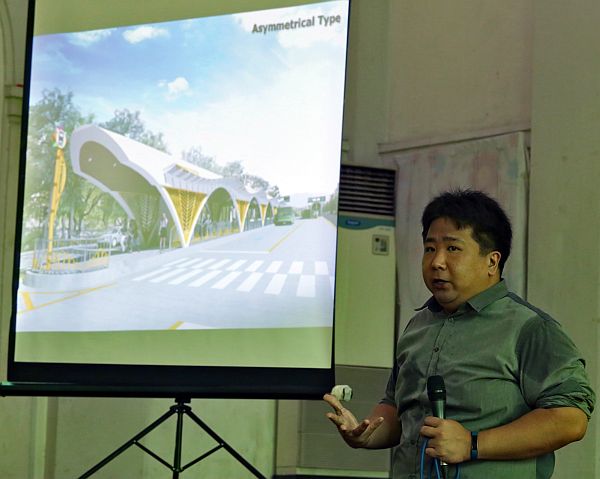
Atty. Rafael Yap, Bus Rapid Transit (BRT) project manager, presents a photo of a BRT asymmetrical type bus station during a public consultation on the P10-billion BRT project which will affect old trees standing within the BRT route.
CDN PHOTO/JUNJIE MENDOZA
BRT PUBLIC HEARING
The hundreds of trees that will be affected by Cebu City’s P10-billion Bus Rapid Transit (BRT) project will not die even if they are uprooted and transplanted to other areas.
Such was the assurance given by BRT project manager Rafael Yap during a public hearing held yesterday where once again, officials faced questions on the project’s massive impact on grown trees falling within the BRT route which spans 21 Cebu City barangays.
Taking up the cudgels for BRT proponents, Yap vowed to take full responsibility if the trees were not properly transferred as agreed.
“I will be accountable. There was a representative from PEJC (Philippine Earth Justice Center) who read to us all of the laws against the cutting of trees. Guess who’s going to jail (if laws are not followed)? Me,” he said, following a question from a concerned citizen.
After Wednesday’s consultation, other hearings will be held in all of the 21 barangays which will be affected by the project as their approval, through separate village resolutions, is part of the process to be able to begin construction.
Residents of Barangays Kinasang-an and Poblacion Pardo raised concerns that the BRT route will affect their private properties.
Yap assured that these concerns will be addressed in a different consultation which will focus on road right of way (RROW) acquisition, relocation sites and compensation for affected private properties.
The first phase of the project will be along Osmeña Blvd. where no RROW acquisition is needed considering the size of the current road which is wide enough to accommodate buses.
“We see as a very realistic target that by third to fourth quarter of 2018, we will already be able to start construction of the project,” Yap said.
The public hearing, which was conducted at the Plaza Rizal Library and Museum, was attended by representatives of different nongovernment organizations, officials and residents of the affected barangays.
The BRT route will start at Barangay Bulacao in the south and pass through Osmeña Blvd., going to Escario St.
From there, the buses will pass by Ayala and go straight all the way up to Barangay Talamban in the north.
The BRT–Project Implementation Unit (PIU), together with the Cebu City Environment and Natural Resources Office (CCENRO) counted a total of 2,182 trees standing along this route.
The mayor’s environmental consultant, Nida Cabrera, said that out of the total number of affected trees, 1,985 will be earthballed or transferred while 197 will have to be cut.
CCENRO staff Joey Baclayon assured that based on the city’s experience in earthballing, the trees have a 100 percent survival rate.
The city, according to Baclayon, has gained the “expertise” after having earthballed trees in the past.
“There are proven methods in the removal and transplanting of trees. We ensure 100 percent survival if we follow this,” said Baclayon, who also used to be the Cebu City agriculturist.
Earthballing process
According to Baclayon, in order to avoid the trees’ dehydration and stress, they will have to be carefully removed within a period of two weeks.
Lateral roots, he said, will be cut, leaving only the top root while branches will be reduced to only 30 percent.
As the trees are transported to their new site, the base of the trees will then be wrapped in sheets.
Baclayon further explained that once the trees are transferred, they will have to be monitored regularly for two years; after which, it can be assured that the trees will continue to survive even if left alone.
The trees that will be affected by the BRT project include narra (664), Indian (491), fire tree (471), mahogany (203) and ipil-ipil (196).
Cebu City Parks and Playgrounds Commission Executive Director Librado Macaraya said that they have already come up with an initial inventory of the trees that they will transplant to the city’s different parks, sidewalks and walkways.
As of yesterday, he said they will be needing at least 179 narra trees and 74 fire trees which will be placed in areas like Plaza Independencia, Plaza Sugbo, Senior Citizens Park and Magellan’s Park.
The rest will be transferred to sites mostly within the North Reclamation Area (NRA) where there are less trees along sidewalks.
Earthballing and tree-cutting permits will be secured along with the city’s application for an Environmental Compliance Certificate (ECC) with the Department of Environment and Natural Resources (DENR).
“Even if the BRT project will not yet start construction, we will already start the earthballing of the trees once we get the ECC and the permits. We hope to do this within the year,” Cabrera said.